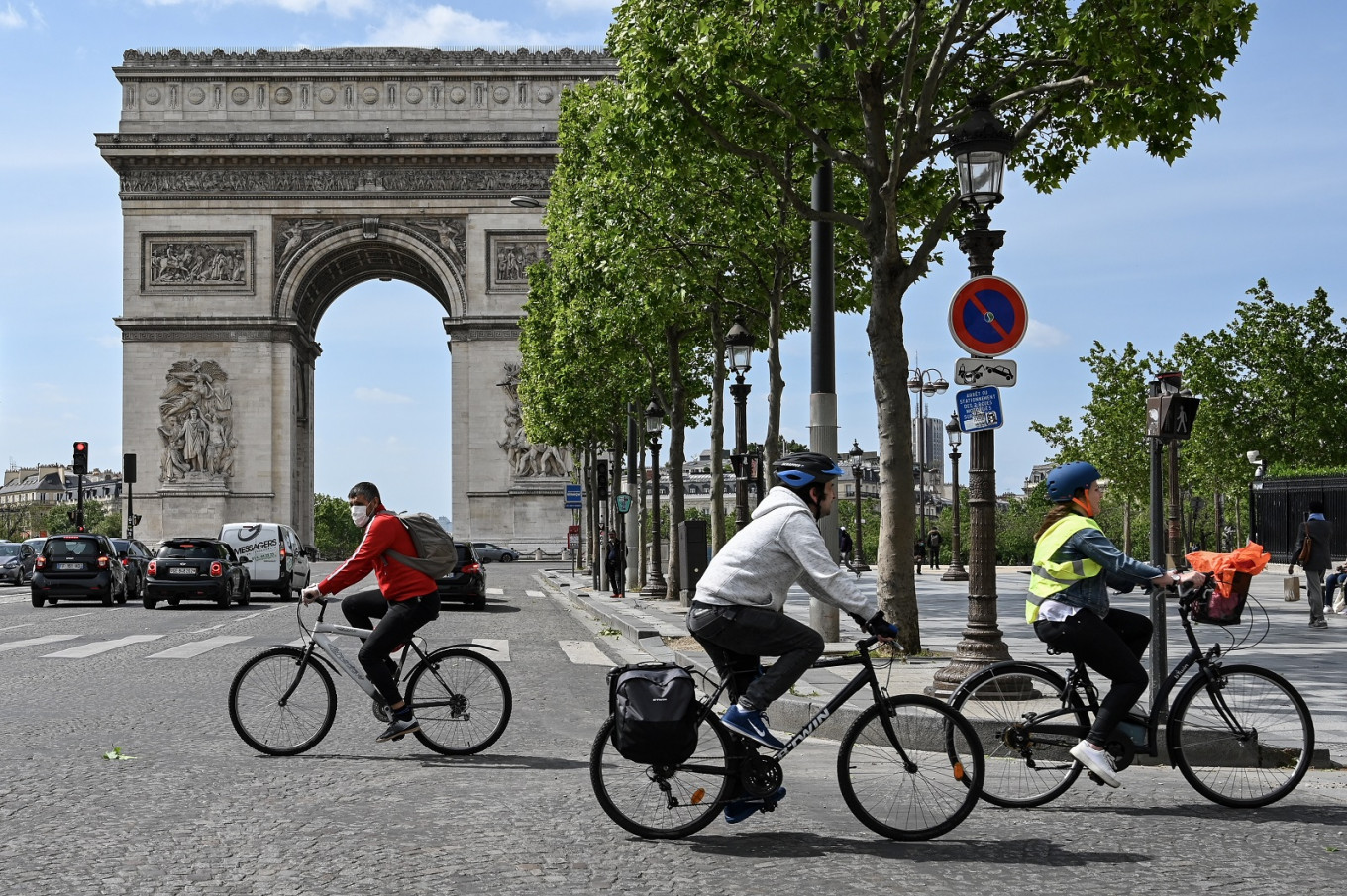Popular Reads
Top Results
Can't find what you're looking for?
View all search resultsPopular Reads
Top Results
Can't find what you're looking for?
View all search resultsBikes wedge their way into heavy Paris traffic
Since France emerged from its two-month lockdown in May, the number of cyclists in Paris has skyrocketed, increasing by more than 50 percent, according to the city council. Videos on social media of packs of cyclists along the Rue de Rivoli -- a historic, bustling thoroughfare that cuts across central Paris -- elicited astonished reactions online.
Change text size
Gift Premium Articles
to Anyone
S
tein van Oosteren was cycling along the Avenue Denfert Rochereau in Paris when, to his surprise, he found himself in a "caravan" of bikes.
"Not too long ago, I was all alone on that street," he said.
An avid cyclist and spokesman for the community-led biking advocacy organization Collectif Velo Ile-de-France, van Oosteren has plenty of company these days.
Since France emerged from its two-month lockdown in May, the number of cyclists in Paris has skyrocketed, increasing by more than 50 percent, according to the city council.
Videos on social media of packs of cyclists along the Rue de Rivoli -- a historic, bustling thoroughfare that cuts across central Paris -- elicited astonished reactions online.
Fifty kilometers of temporary bike lanes were set up during the lockdown within the ring road, and another 100 km in the surrounding suburbs.
However, the two-wheel boom, experts and advocates say, is not a happy accident but the result of years of planning to cut polluting traffic on choked roads accelerated by several crises.
"The great thing about Paris is not so much that they made some pop-up bike lanes, that's just the tip of the iceberg," said Stefan Bendiks, director of Artgineering, a Brussels-based mobility design firm.
"They worked for years on a consistent strategy for improving the city and having a good narrative about it."
A tale of two crises
During a massive, weeks-long transport strike in December and January, the number of cyclists on some streets more than doubled, said van Oosteren, a dual Dutch-French citizen.
That happened again in the weeks after the virus lockdown eased, he added.
More than 15,000 riders took out an annual subscription for Velib', the Paris public bike share system, in the first week of May.
Many Parisians have also dusted off their old bikes, taking advantage of a state-funded nationwide scheme that offers 50 euros ($57) towards bike repairs.
The initiative, launched on May 11, cost an estimated 20 million euros.
It aimed for 300,000 repairs by year's end but nearly reached that figure within a month and a half, said Olivier Schneider, head of the Federation des Usagers de la Bicyclette, an umbrella organisation of 365 cycling advocacy groups across France.
Bike repair shops contacted by AFP had waiting times of between one and a half and three months, even for the simplest fix.
Read also: Taiwan pedals faster to meet global pandemic demand for bikes
The Dutch model
"For 40 years, we were under the impression that nobody was listening to us," Schneider said.
"But the bike always comes around in times of crisis."
After the 1973 oil crisis, The Netherlands was the first European country to heavily invest in bike infrastructure.
In the late 1970s, Denmark developed cycling after a proposed highway infrastructure network was deemed too expensive.
Paris, however, did not wait for a crisis.
Since 2015, it has invested 150 million euros as part of a goal to become a "world cycling capital".
The five-year plan included doubling Paris cycle lanes from 700 to 1,400 km, creating 10,000 bike parking spots and upgrading the Velib’ system, which had been falling into disrepair.
Even before the Rue de Rivoli converted two vehicle lanes into bike paths, a number of streets and highways were shut down or narrowed to make room for more bikes.
But the COVID-19 crisis, experts say, gave the city an impetus to rapidly connect the disparate parts of this network.
"When you create a bike path, it's no good until you connect it to a network," van Oosteren said.
"It's like building a faucet and not connecting it to the water system."
Green wave
The drive to cut car traffic in France isn't limited to the capital.
Seventy cities and towns in the Paris region have a cycling infrastructure plan, Stephane Beaudet, vice president of Ile-de-France Mobilites and mayor of Evry-Courcouronnes, a suburb about 30 km from Paris, told AFP by phone.
"That's previously unheard of," he said.
Spending on cycling infrastructure across the region has more than doubled since 1995, to 25 million euros per year, he added.
In Strasbourg, Bordeaux, Grenoble and other cities, more than 10 percent of all trips between home and work are by bike, according to Ministry of Ecological and Solidarity Transition figures.
A string of local election wins by France's Greens in major cities including Lyon, Strasbourg and Bordeaux suggests that ambitious cycling infrastructure plans could become the norm.
"The results of the most recent elections show that there is popular demand for new modes of transportation and that's going to continue into the future," said Jean-Sebastien Catier, of Paris en Selle, a bike advocacy organisation.
A symbol to the world
Paris' dense city center still nonetheless poses problems for cyclists, with some bike lanes running against traffic along narrow streets and others hastily painted on pavements.
Hurdles such as a powerful car lobby and insufficient bike parking options also remain.
Last month, to the dismay of cycling advocates, a TV ad by electric bike company VanMoof was rejected by the French advertising authority for "creating a climate of anxiety" after referring to CO2 emissions from cars.
But, if Paris can get people on their bikes, "there's no longer an excuse for a lot of other cities in the world", said Angela van der Kloof, a researcher at Mobycon, a network of Dutch cycling experts.
Catier agreed.
"The symbolic nature of Paris and the fact that what it's doing is quite ambitious... shows that we can do this anywhere."











